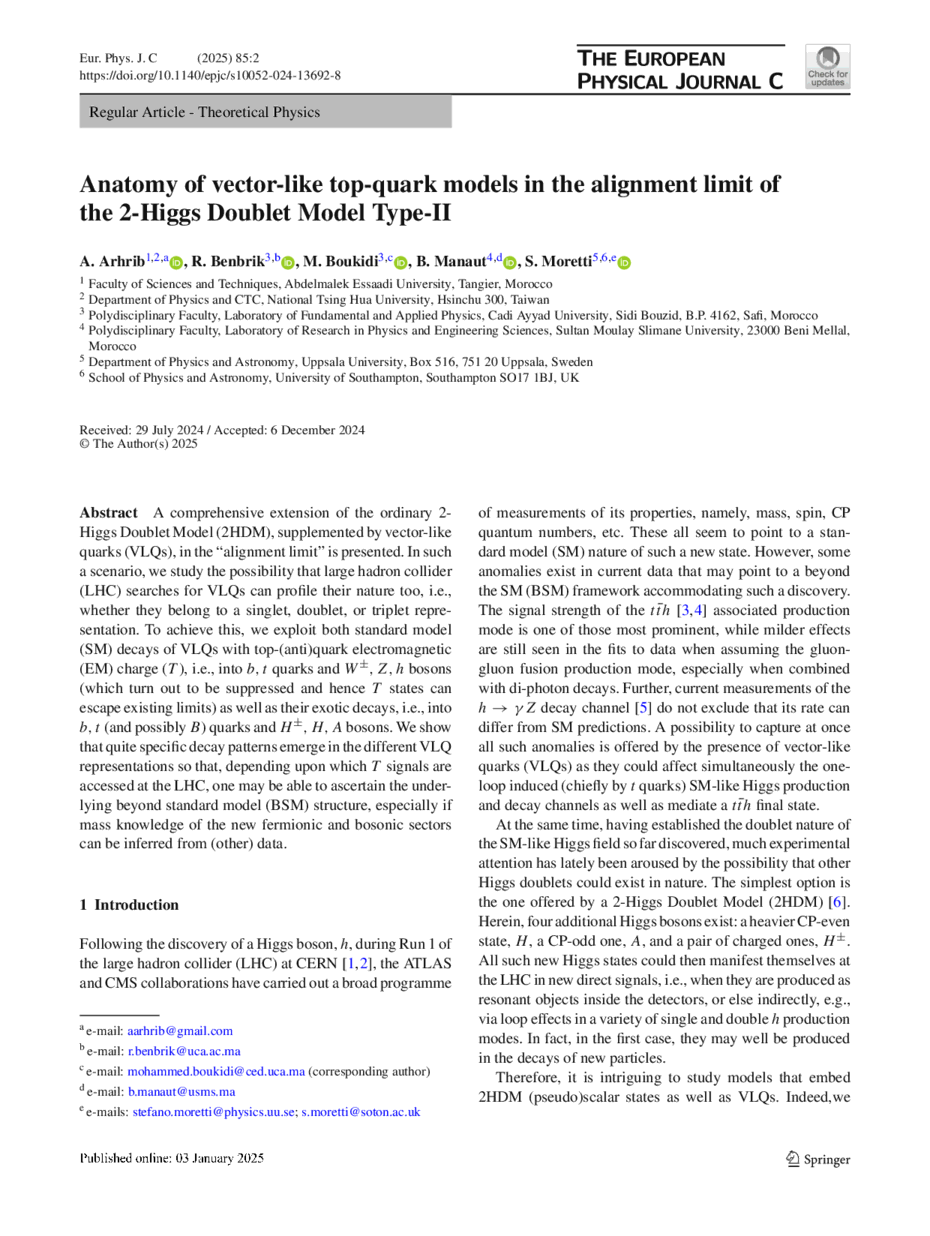https://doi.org/10.1140/epjc/s10052-024-13692-8
Regular Article - Theoretical Physics
Anatomy of vector-like top-quark models in the alignment limit of the 2-Higgs Doublet Model Type-II
1
Faculty of Sciences and Techniques, Abdelmalek Essaadi University, Tangier, Morocco
2
Department of Physics and CTC, National Tsing Hua University, 300, Hsinchu, Taiwan
3
Polydisciplinary Faculty, Laboratory of Fundamental and Applied Physics, Cadi Ayyad University, B.P. 4162, Sidi Bouzid, Safi, Morocco
4
Polydisciplinary Faculty, Laboratory of Research in Physics and Engineering Sciences, Sultan Moulay Slimane University, 23000, Beni Mellal, Morocco
5
Department of Physics and Astronomy, Uppsala University, Box 516, 751 20, Uppsala, Sweden
6
School of Physics and Astronomy, University of Southampton, SO17 1BJ, Southampton, UK
Received:
29
July
2024
Accepted:
6
December
2024
Published online:
3
January
2025
A comprehensive extension of the ordinary 2-Higgs Doublet Model (2HDM), supplemented by vector-like quarks (VLQs), in the “alignment limit” is presented. In such a scenario, we study the possibility that large hadron collider (LHC) searches for VLQs can profile their nature too, i.e., whether they belong to a singlet, doublet, or triplet representation. To achieve this, we exploit both standard model (SM) decays of VLQs with top-(anti)quark electromagnetic (EM) charge (T), i.e., into b, t quarks and  bosons (which turn out to be suppressed and hence T states can escape existing limits) as well as their exotic decays, i.e., into b, t (and possibly B) quarks and
bosons (which turn out to be suppressed and hence T states can escape existing limits) as well as their exotic decays, i.e., into b, t (and possibly B) quarks and  bosons. We show that quite specific decay patterns emerge in the different VLQ representations so that, depending upon which T signals are accessed at the LHC, one may be able to ascertain the underlying beyond standard model (BSM) structure, especially if mass knowledge of the new fermionic and bosonic sectors can be inferred from (other) data.
bosons. We show that quite specific decay patterns emerge in the different VLQ representations so that, depending upon which T signals are accessed at the LHC, one may be able to ascertain the underlying beyond standard model (BSM) structure, especially if mass knowledge of the new fermionic and bosonic sectors can be inferred from (other) data.
© The Author(s) 2025
 Open Access This article is licensed under a Creative Commons Attribution 4.0 International License, which permits use, sharing, adaptation, distribution and reproduction in any medium or format, as long as you give appropriate credit to the original author(s) and the source, provide a link to the Creative Commons licence, and indicate if changes were made. The images or other third party material in this article are included in the article’s Creative Commons licence, unless indicated otherwise in a credit line to the material. If material is not included in the article’s Creative Commons licence and your intended use is not permitted by statutory regulation or exceeds the permitted use, you will need to obtain permission directly from the copyright holder. To view a copy of this licence, visit http://creativecommons.org/licenses/by/4.0/.
Open Access This article is licensed under a Creative Commons Attribution 4.0 International License, which permits use, sharing, adaptation, distribution and reproduction in any medium or format, as long as you give appropriate credit to the original author(s) and the source, provide a link to the Creative Commons licence, and indicate if changes were made. The images or other third party material in this article are included in the article’s Creative Commons licence, unless indicated otherwise in a credit line to the material. If material is not included in the article’s Creative Commons licence and your intended use is not permitted by statutory regulation or exceeds the permitted use, you will need to obtain permission directly from the copyright holder. To view a copy of this licence, visit http://creativecommons.org/licenses/by/4.0/.
Funded by SCOAP3.





